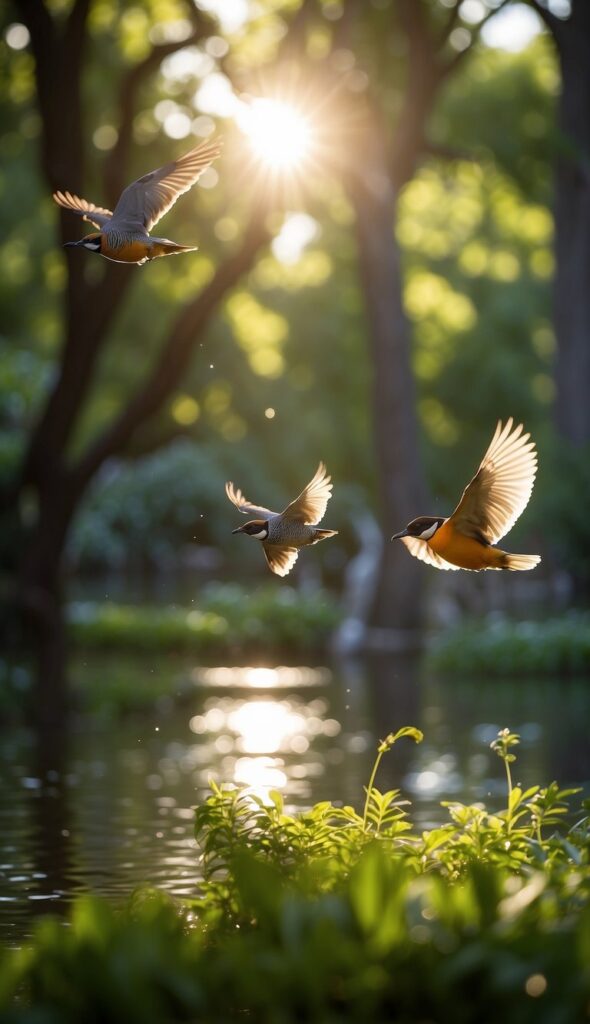Amazon Associates Disclaimer: lostinmemphis.com is a participant in the Amazon Services LLC Associates Program, an affiliate advertising program designed to provide a means for sites to earn advertising fees by advertising and linking to Amazon.com. As an Amazon Associate, we may earn from qualifying purchases.
Contains affiliate links.
Nestled along the banks of the mighty Mississippi River, Memphis, Tennessee, beckons birdwatching enthusiasts with its rich tapestry of avian diversity and picturesque landscapes. As you embark on your avian adventure in this vibrant city, prepare to be enchanted by the melodic trills of songbirds echoing through lush woodlands and the graceful flight of waterfowl gliding across serene lakeshores. But beyond the captivating birdlife, Memphis offers a myriad of attractions to explore, from the historic charm of Beale Street to the cultural allure of Graceland, the former home of music icon Elvis Presley.
Amidst the hustle and bustle of city life, Memphis boasts an impressive array of green spaces that serve as sanctuaries for both birds and humans alike. Shelby Farms Park stands as a verdant oasis, offering miles of scenic trails, tranquil lakes, and abundant wildlife viewing opportunities. Meanwhile, Overton Park captivates visitors with its enchanting forests, meandering streams, and expansive lawns perfect for picnics or leisurely strolls. And for those seeking a closer connection to the mighty Mississippi, the Mississippi River Greenbelt provides a stunning backdrop for birdwatching excursions, with its sprawling floodplains and wetland habitats teeming with life.
So, whether you’re a seasoned birder or a curious newcomer to the world of birdwatching, Memphis invites you to embark on an unforgettable journey of discovery. With its diverse ecosystems, prime birdwatching locations, and vibrant cultural attractions, this charming city offers endless opportunities to connect with nature and immerse yourself in the beauty of the avian world.
Table of Contents
A Tapestry of Avian DiversitY
Before delving into the seasonal migrations and year-round residents that grace Memphis’s skies, it’s essential to appreciate the rich tapestry of avian diversity that characterizes this region. Memphis serves as a crossroads for a fascinating array of bird species, thanks to its varied habitats ranging from dense woodlands to expansive wetlands. Throughout the year, birdwatchers can witness a mesmerizing spectacle of winged wonders, from the elegant swoop of migratory raptors to the delicate flutter of colorful songbirds. Whether you’re captivated by the majestic presence of waterfowl on the Mississippi River or the elusive charm of marsh birds in secluded swamps, Memphis offers an unparalleled opportunity to immerse yourself in the vibrant world of avian life.
Exploring the Seasonal Migrations
Exploring the seasonal migrations in Memphis unveils a dynamic spectacle of avian activity that ebbs and flows with the changing seasons. As temperatures shift and daylight hours fluctuate, birdwatchers are treated to a captivating display of migration patterns that shape the city’s avian landscape. During the fall and spring migrations, Memphis serves as a crucial waypoint for millions of birds as they journey between their breeding and wintering grounds.
In the fall, flocks of waterfowl, including ducks, geese, and swans, descend upon the city’s waterways and wetlands, pausing to rest and refuel before continuing their journey southward. Meanwhile, songbirds embark on epic journeys, their vibrant plumage adding bursts of color to the autumnal landscape as they traverse the skies above Memphis.
Come spring, the return migration brings a renewed sense of energy and vitality to the region. Warblers, thrushes, and other songbirds make their triumphant return, their cheerful melodies heralding the arrival of warmer weather. Raptors, such as hawks and eagles, ride the thermals overhead, scanning the landscape for prey as they migrate northward to their breeding grounds.
For birdwatchers, exploring these seasonal migrations offers a unique opportunity to witness the wonders of nature in motion. Whether you’re observing the aerial ballet of migrating shorebirds along the Mississippi River or marveling at the sight of warblers flitting through the blooming spring foliage, Memphis provides an ideal vantage point to experience the awe-inspiring spectacle of avian migration.
Year-Round Residents and Rare Sightings
In Memphis, the avian tapestry extends beyond seasonal migrations, with a diverse cast of year-round residents and occasional rare sightings adding intrigue to the city’s birdwatching scene. Throughout the year, a fascinating array of birds call Memphis home, from iconic raptors like the Red-tailed Hawk to the charismatic Eastern Bluebird, each contributing to the city’s rich biodiversity.
Among the year-round residents, visitors may encounter the majestic Great Horned Owl perched silently in the cover of night, or the vibrant Northern Cardinal, its brilliant plumage a splash of color against the backdrop of city parks. In the wetlands and marshes, the elusive American Bittern may reveal itself with its cryptic plumage, blending seamlessly into its surroundings.
Beyond the familiar faces, Memphis occasionally plays host to rare and unexpected avian visitors, adding an element of excitement to any birdwatching outing. From vagrant species blown off course by storms to uncommon migrants passing through on their way to distant destinations, these sightings offer birdwatchers the chance to witness the extraordinary and expand their understanding of avian diversity.
Whether you’re seeking out the resident species that call Memphis home year-round or hoping to catch a glimpse of a rare visitor passing through, the city’s birdwatching opportunities are as diverse as its avian inhabitants. With patience, keen observation, and a bit of luck, birdwatchers in Memphis can uncover a world of wonders hidden in plain sight.
Prime Birdwatching Locations
Discovering prime birdwatching locations in Memphis unveils a treasure trove of diverse habitats teeming with avian life. Whether you’re an avid birder or a casual observer, Memphis offers a wealth of opportunities to connect with nature and observe birds in their natural habitats. From sprawling parks to tranquil riverside sanctuaries, each prime birdwatching location in Memphis presents a unique ecosystem waiting to be explored.
Shelby Farms Park stands as a crown jewel among Memphis’s birdwatching destinations, boasting expansive woodlands, serene lakeshores, and diverse wetland habitats that provide refuge for a wide variety of bird species. Meanwhile, Overton Park offers an urban oasis where lush forests, meandering streams, and manicured gardens provide sanctuary for both birds and birdwatchers alike. And along the banks of the mighty Mississippi River, the Mississippi River Greenbelt beckons with its sweeping floodplains and picturesque wetlands, offering unparalleled opportunities to observe waterfowl and migratory birds in their seasonal habitats. Whether you’re seeking solace in nature or hoping to add new species to your birding checklist, these prime birdwatching locations in Memphis promise an unforgettable avian adventure.
Shelby Farms Park: A Birding Paradise
Shelby Farms Park emerges as a veritable birding paradise within the heart of Memphis, Tennessee, captivating enthusiasts with its sprawling landscapes and diverse ecosystems. Spanning over 4,500 acres, this expansive park offers a haven for avian residents and migratory visitors alike, making it a premier destination for birdwatchers of all levels.
As visitors wander along the network of scenic trails that wind through lush woodlands and verdant meadows, they’re greeted by a symphony of bird songs echoing through the trees. From the melodic trills of warblers to the haunting calls of barred owls, Shelby Farms Park teems with a rich array of birdlife waiting to be discovered around every bend.
Tranquil lakeshores provide ideal vantage points for observing waterfowl and shorebirds, while the park’s wetland habitats offer glimpses of elusive marsh birds and wading species. Whether you’re scanning the skies for soaring raptors or quietly observing songbirds flitting among the branches, Shelby Farms Park promises unforgettable encounters with nature at its finest.
With its commitment to conservation and habitat preservation, Shelby Farms Park not only provides a sanctuary for birds but also serves as a living laboratory for environmental education and awareness. Through guided birding tours, educational programs, and citizen science initiatives, visitors have the opportunity to deepen their understanding of avian ecology and contribute to ongoing conservation efforts.
For birdwatchers seeking serenity and natural beauty, Shelby Farms Park stands as an enduring testament to the power of nature to inspire, uplift, and connect us to the world around us. Amidst the hustle and bustle of city life, this hidden gem invites visitors to slow down, embrace the wonder of the natural world, and embark on an unforgettable avian adventure.
Overton Park: Urban Birding at Its Finest
Overton Park, nestled in the heart of Memphis, Tennessee, offers a captivating blend of urban charm and natural beauty, making it a premier destination for urban birding enthusiasts. Spanning over 342 acres, this beloved park serves as a verdant oasis amidst the bustling cityscape, providing refuge for both birds and humans alike.
As visitors meander through the park’s enchanting forests, they’re greeted by a chorus of bird songs that fill the air with melody. From the cheerful chirps of chickadees to the haunting calls of woodpeckers echoing through the trees, Overton Park offers a symphony of avian sounds that captivates the senses.
Tranquil streams and meandering trails provide ideal opportunities for birdwatchers to observe a diverse array of species up close. Whether you’re scanning the canopy for perching songbirds or quietly observing waterfowl gliding across the surface of tranquil ponds, Overton Park offers endless possibilities for birding adventures.
But beyond its natural beauty, Overton Park serves as a cultural hub, boasting iconic landmarks such as the Memphis Brooks Museum of Art and the Memphis Zoo. Amidst lush greenery and historic architecture, visitors can immerse themselves in the vibrant cultural tapestry of Memphis while enjoying unparalleled birdwatching opportunities.
With its unique blend of urban sophistication and natural serenity, Overton Park stands as a testament to the power of green spaces to enrich our lives and nourish our souls. Whether you’re seeking solace in nature or exploring the intersection of art, culture, and conservation, Overton Park promises an unforgettable urban birding experience like no other.
Mississippi River Greenbelt: A Waterfowl Wonderland
The Mississippi River Greenbelt unfolds as a picturesque haven for birdwatchers, offering a captivating blend of natural beauty and abundant wildlife along the iconic Mississippi River. Spanning miles of pristine floodplains, wetlands, and riverfront habitats, this expansive greenbelt serves as a veritable waterfowl wonderland, attracting an impressive array of avian species year-round.
As visitors wander along the river’s edge, they’re treated to panoramic vistas of sweeping marshes and tranquil backwaters teeming with waterfowl. Majestic ducks, graceful geese, and elegant herons dot the landscape, their vibrant plumage contrasting against the shimmering waters of the mighty Mississippi.
During the fall and spring migrations, the greenbelt comes alive with the sights and sounds of thousands of birds as they gather to rest and refuel on their long journey. From raucous flocks of migrating waterfowl to solitary shorebirds probing the muddy shores for food, the greenbelt offers unparalleled opportunities for birdwatchers to witness the awe-inspiring spectacle of avian migration.
But the allure of the Mississippi River Greenbelt extends beyond its resident and migratory bird populations. The expansive network of trails and boardwalks provides access to secluded birding hotspots and panoramic overlooks, allowing visitors to immerse themselves in the tranquility of nature while observing a diverse array of bird species in their natural habitats.
Whether you’re scanning the skies for soaring eagles or quietly observing waterfowl from a riverside blind, the Mississippi River Greenbelt promises an unforgettable birdwatching experience for enthusiasts of all ages and skill levels. Amidst the timeless beauty of the Mississippi River, this scenic sanctuary invites visitors to connect with nature and revel in the wonders of the avian world.
T.O. Fuller State Park: Discovering Avian Diversity in a Natural Oasis
Nestled just a stone’s throw away from the vibrant heartbeat of downtown Memphis lies T.O. Fuller State Park, a sprawling natural oasis that beckons birdwatchers with its diverse ecosystems and rich avian tapestry. Spanning over 1,100 acres, this hidden gem offers a haven for both resident and migratory bird species, making it a prime destination for enthusiasts eager to discover the wonders of birdlife in their natural habitats.
As visitors venture into the depths of T.O. Fuller State Park, they’re greeted by a symphony of bird songs that fill the air with melodic harmony. From the haunting calls of barred owls echoing through the forest to the cheerful chirps of songbirds flitting among the branches, the park’s woodlands come alive with avian activity year-round.
Tranquil lakes and meandering streams provide ideal habitats for waterfowl and shorebirds, while open grasslands offer prime hunting grounds for raptors and ground-nesting species. With its diverse array of habitats, T.O. Fuller State Park provides endless opportunities for birdwatchers to observe a wide variety of species, from iconic residents like the Eastern Bluebird to rare migrants passing through on their seasonal journeys.
But beyond its natural beauty, T.O. Fuller State Park holds a special significance as one of the nation’s first state parks created specifically for African Americans during the era of segregation. Today, visitors can explore the park’s rich cultural heritage while immersing themselves in the timeless beauty of nature, creating a truly unforgettable birdwatching experience that celebrates both the diversity of avian life and the enduring spirit of human resilience.
Lichterman Nature Center: A Tranquil Haven for Birding Enthusiasts
Nestled amidst the urban landscape of Memphis, the Lichterman Nature Center stands as a tranquil haven for birding enthusiasts seeking solace in nature’s embrace. This serene sanctuary, spanning over 65 acres, offers a diverse tapestry of habitats, including woodlands, meadows, and aquatic gardens, that attract a rich array of avian species throughout the year.
As visitors step into the peaceful confines of the Lichterman Nature Center, they are enveloped by the soothing sounds of nature and the gentle rustle of leaves overhead. Meandering trails wind through the lush woodlands, providing ample opportunities to spot elusive songbirds flitting among the branches or observe colorful warblers foraging for insects.
Tranquil ponds and meandering streams offer ideal habitats for waterfowl and wading birds, while strategically placed bird blinds provide discreet vantage points for observing birds up close without disturbing their natural behaviors. Whether you’re scanning the skies for soaring raptors or quietly observing waterfowl paddling across the glassy surface of a pond, the Lichterman Nature Center offers unparalleled opportunities for birdwatchers to connect with nature and revel in the beauty of the avian world.
But beyond its natural beauty, the Lichterman Nature Center is also dedicated to environmental education and conservation, offering a variety of educational programs and workshops designed to inspire a deeper appreciation for the natural world. Through guided birding walks, bird banding demonstrations, and hands-on activities, visitors of all ages can learn about the importance of habitat preservation and wildlife conservation while exploring the wonders of birdlife in their own backyard.
In a bustling city where skyscrapers and concrete dominate the landscape, the Lichterman Nature Center stands as a testament to the enduring power of nature to nurture the soul and awaken the senses. Whether you’re a seasoned birder or a curious newcomer, this tranquil oasis invites you to escape the hustle and bustle of urban life and embark on an unforgettable journey of discovery through the captivating world of birds.
Tips and Techniques for Birdwatching Success
Before embarking on your birdwatching adventure in Memphis, it’s essential to equip yourself with the knowledge and skills needed to maximize your experience and make the most of your time in the field. In this section, we’ll explore a range of tips and techniques to help you become a more proficient birder, from essential gear and equipment to field identification strategies and ethical birding practices.
Firstly, we’ll delve into the essential gear and equipment every birdwatcher should have in their arsenal, from high-quality binoculars and field guides to birding apps and camera gear. Next, we’ll discuss field identification strategies, including tips for distinguishing between similar bird species based on plumage, behavior, and habitat preferences. Finally, we’ll explore the principles of ethical birding and conservation, emphasizing the importance of respecting wildlife and minimizing our impact on the environment while enjoying the beauty of nature. Whether you’re a novice enthusiast or a seasoned birder, these tips and techniques will help you enhance your birdwatching skills and deepen your connection to the avian world.
Essential Gear and Equipment
When preparing for a birdwatching expedition in Memphis, having the right gear and equipment can make all the difference in your experience. Here’s a comprehensive breakdown of essential items to consider packing for your birding adventure:
- Binoculars: A quality pair of binoculars is perhaps the most essential tool for birdwatching. Look for binoculars with good magnification (8x to 10x) and a wide field of view for easy tracking of birds in flight. Consider options like the Nikon Monarch 5 or the Vortex Optics Diamondback. These binoculars offer superior optics and ergonomic design, ensuring clear, crisp views of even the most distant birds.
- Field Guide: A reliable field guide is invaluable for identifying bird species in the field. Choose a guide that is specific to the birds of your region, such as “The Sibley Field Guide to Birds of Eastern North America” or “National Geographic Field Guide to the Birds of North America.” These comprehensive guides feature detailed illustrations, range maps, and species descriptions to help you confidently identify birds on your birdwatching outings.
- Birding Apps: Supplement your field guide with birding apps that provide additional information and tools for bird identification. Popular options include Merlin Bird ID, iBird, and Audubon Bird Guide. These apps offer features such as digital field guides, bird song recordings, and interactive identification keys, allowing you to enhance your birdwatching experience and learn more about the birds you encounter.
- Notebook and Pen: Keep a notebook and pen handy for jotting down observations, sketching bird behaviors, or recording species sightings. Consider a waterproof notebook like the Rite in the Rain All-Weather Side-Spiral Notebook. This durable notebook features water-resistant paper and a sturdy spiral binding, making it ideal for outdoor use in all weather conditions.
- Camera: Capture memorable moments and document bird sightings with a digital camera or smartphone equipped with a telephoto lens. Options like the Canon EOS Rebel T7i DSLR or the iPhone 12 Pro Max offer excellent photo and video capabilities for birdwatching enthusiasts. These cameras feature high-resolution sensors, fast autofocus systems, and long zoom lenses, allowing you to capture stunning images of birds in their natural habitats.
- Field Clothing: Dress comfortably and appropriately for the weather conditions, opting for lightweight, moisture-wicking clothing in breathable fabrics. Consider items like the Columbia Silver Ridge Convertible Pants and the Patagonia Capilene Cool Daily Shirt. These garments are designed for outdoor performance, offering UPF sun protection, moisture management, and breathability for long days of birdwatching in the field.
- Backpack: Carry your gear and essentials in a sturdy backpack with padded straps for comfort during long hikes. Look for features like multiple compartments and water bottle pockets. Consider options like the Osprey Daylite Plus Daypack or the REI Co-op Flash 22 Pack. These backpacks offer ample storage space, organizational pockets, and comfortable carrying systems, making them ideal companions for birdwatching excursions in Memphis and beyond.
Field Identification Strategies
Field identification is a fundamental skill for any birdwatcher, allowing you to confidently distinguish between similar species based on key characteristics such as plumage, behavior, and habitat preferences. Here are some essential field identification strategies to help you sharpen your birding skills and become a more proficient birder:
- Study Field Guides: Familiarize yourself with field guides specific to the birds of your region, such as “The Sibley Field Guide to Birds of Eastern North America” or “National Geographic Field Guide to the Birds of North America.” Study the illustrations, range maps, and species descriptions to learn about the distinctive features and identifying marks of different bird species.
- Observe Behavior: Pay close attention to the behavior of birds in the field, as it can provide valuable clues for identification. Note how birds move, feed, and interact with their surroundings. For example, certain species may have unique feeding behaviors, such as probing for insects in tree bark or foraging in shallow water.
- Listen to Vocalizations: Bird songs and calls are often distinctive and can be a helpful aid for identification, especially when visual cues are limited. Familiarize yourself with the vocalizations of common bird species in your area by listening to recordings or using birding apps like Merlin Bird ID. Practice associating specific songs and calls with their corresponding bird species to enhance your identification skills.
- Focus on Field Marks: When observing birds in the field, focus on key field marks such as color patterns, size and shape, bill shape and size, and distinctive markings or features. Pay attention to details like wing bars, eye rings, and tail patterns, as these can vary significantly between species and help narrow down identification.
- Consider Habitat and Range: Take note of the habitat preferences and range of each bird species, as these factors can provide important context for identification. Certain birds are associated with specific habitats, such as forests, grasslands, or wetlands, while others may have overlapping ranges with similar species.
- Use Binoculars: Utilize binoculars to get a closer look at birds and observe fine details that may not be visible to the naked eye. Practice adjusting the focus and magnification settings to achieve clear, sharp views of birds in various lighting conditions.
- Practice Patience and Persistence: Bird identification takes time and practice, so don’t be discouraged if you’re unable to identify a bird right away. Take your time to observe each bird carefully, noting its features and behavior, and consult your field guide or birding apps for confirmation. With patience and persistence, your identification skills will improve over time, allowing you to confidently identify birds in the field.
By incorporating these field identification strategies into your birdwatching routine, you’ll develop the confidence and expertise needed to identify a wide variety of bird species with ease and precision. Remember to approach each birdwatching outing with curiosity and enthusiasm, and enjoy the process of discovering the rich diversity of avian life in Memphis and beyond.
Ethical Birding Practices
Ethical birding practices are essential for ensuring the well-being of birds and their habitats while minimizing our impact on the environment. As birdwatchers, it’s our responsibility to observe and enjoy birds in a manner that respects their natural behaviors and habitats. Here are some key ethical birding practices to keep in mind:
- Respect Wildlife: Always prioritize the welfare of birds and other wildlife by observing from a respectful distance and avoiding any actions that may disturb or harass them. Use binoculars or spotting scopes to get a closer look without intruding on their space, and never attempt to approach birds too closely or disturb nesting sites.
- Stay on Trails: When exploring birding locations, stick to designated trails and pathways to minimize trampling of sensitive habitats and nesting areas. Avoid venturing off-trail into fragile ecosystems, wetlands, or protected areas where birds may be nesting or feeding.
- Leave No Trace: Practice Leave No Trace principles by packing out all trash and litter, including food wrappers, water bottles, and other debris. Dispose of waste properly in designated trash receptacles or carry it out with you to ensure that bird habitats remain clean and pristine for future generations.
- Avoid Playback and Disturbance: Refrain from using bird call playback or other attractants to lure birds closer for viewing or photography, as this can disrupt their natural behaviors and cause unnecessary stress. Similarly, avoid making loud noises, sudden movements, or excessive disturbances that may frighten or alarm birds.
- Be Mindful of Nesting Birds: During the breeding season, be particularly cautious around nesting birds and their young, as disturbances can disrupt nesting activities and cause abandonment of nests. Observe nesting birds from a distance and avoid lingering in their vicinity to minimize disturbance.
- Educate and Inspire Others: Share your knowledge and passion for birds with others and encourage them to adopt ethical birding practices. Lead by example by demonstrating respect and reverence for wildlife, and inspire others to develop a deeper appreciation for the natural world.
- Support Conservation Efforts: Get involved in local bird conservation initiatives and habitat restoration projects aimed at protecting bird habitats and populations. Volunteer with conservation organizations, participate in citizen science programs, and advocate for policies that prioritize the conservation of birds and their habitats.
By adhering to these ethical birding practices, we can enjoy the beauty of birds while ensuring their continued survival and conservation for future generations to appreciate and enjoy. Let’s strive to be responsible stewards of the natural world and protect the precious resources that birds depend on for their survival.
Community Engagement and Conservation Initiatives
In this Section, we delve into the vital role of community engagement and conservation initiatives in preserving Memphis’s rich avian biodiversity and promoting a sustainable future for birds and their habitats. From grassroots efforts to large-scale conservation projects, the Memphis community is actively involved in initiatives aimed at protecting and enhancing bird populations, fostering environmental stewardship, and raising awareness about the importance of bird conservation. In this section, we’ll explore various community-led initiatives, partnerships with conservation organizations, and opportunities for individuals to get involved in bird-related conservation efforts across Memphis. Through collaborative action and collective commitment, we can work together to safeguard the natural treasures of our city and ensure a brighter future for birds and humans alike.
Joining Local Birding Groups
Joining local birding groups offers a wonderful opportunity to engage with fellow enthusiasts, deepen your understanding of local avian species, and actively participate in conservation initiatives within the Memphis community. These groups provide a supportive environment for birdwatchers of all levels, offering guided outings, educational workshops, and hands-on conservation projects. Here are some notable groups in Memphis:
- Memphis Chapter of the Audubon Society: This chapter organizes regular birding field trips to popular local spots like Shelby Farms Park and T.O. Fuller State Park, providing members with valuable opportunities to observe and learn about the region’s diverse birdlife.
- Wolf River Conservancy: Dedicated to the preservation of the Wolf River watershed, this organization hosts birding events and volunteer opportunities focused on habitat conservation and restoration efforts, fostering a deeper connection to the natural world.
- Memphis Botanic Garden’s Bird Friendly Garden Program: Through the Memphis Botanic Garden‘s program, participants learn how to create bird-friendly landscapes and habitats within urban environments, promoting biodiversity and supporting native bird populations.
- Memphis Area Master Gardeners Association: This group offers educational resources and workshops on creating bird-friendly gardens and landscapes, providing valuable insights into native plant species and habitat restoration practices.
- Memphis Zoo’s Conservation Education Programs: The Memphis Zoo offers educational programs focused on wildlife conservation, including bird species native to the region. Participants learn about conservation efforts both locally and globally, inspiring action to protect avian habitats and populations.
By becoming involved with these local birding groups, you not only enrich your birdwatching experience but also play a vital role in safeguarding the ecological health and diversity of Memphis’s avian community.
Supporting Bird Conservation Efforts
Supporting bird conservation efforts is crucial for preserving the rich avian biodiversity of Memphis and beyond. By actively participating in conservation initiatives, individuals can make a meaningful impact on the health and sustainability of bird populations and their habitats. Here are some ways to support bird conservation efforts:
- Volunteer with Local Conservation Organizations: Get involved with local conservation organizations such as the Wolf River Conservancy or the Tennessee Ornithological Society, which often organize volunteer opportunities such as habitat restoration projects, bird surveys, and wildlife monitoring efforts.
- Participate in Citizen Science Programs: Contribute to scientific research and conservation efforts by participating in citizen science programs like eBird or the Great Backyard Bird Count. By recording bird sightings and submitting data to these programs, you help scientists track bird populations and monitor changes in their distribution and abundance over time.
- Support Bird-Friendly Legislation and Policies: Advocate for policies and legislation that protect bird habitats, promote habitat restoration, and mitigate threats to bird populations, such as habitat loss, pollution, and climate change. Stay informed about local and national conservation issues and voice your support for measures that prioritize bird conservation.
- Create Bird-Friendly Habitats: Transform your backyard or community spaces into bird-friendly habitats by planting native vegetation, providing food and water sources, and minimizing the use of pesticides and herbicides. Creating bird-friendly habitats not only benefits local bird populations but also enhances biodiversity and ecosystem health.
- Donate to Conservation Organizations: Support the work of conservation organizations dedicated to protecting birds and their habitats by making financial contributions or becoming a member. Organizations like the National Audubon Society, the American Bird Conservancy, and local birding groups rely on donations to fund conservation projects, advocacy efforts, and educational programs.
- Participate in Bird Banding and Monitoring Programs: Volunteer with bird banding stations or participate in bird monitoring programs to help track bird populations, study migration patterns, and assess the health of bird populations over time. These programs provide valuable data for conservation planning and management efforts.
By supporting bird conservation efforts through volunteering, citizen science, advocacy, habitat restoration, donations, and participation in monitoring programs, individuals can play a vital role in protecting birds and their habitats for future generations to enjoy. Together, we can make a positive impact on the conservation of avian biodiversity and ensure a sustainable future for birds and humans alike.
Conclusion
In conclusion, birdwatching in Memphis is more than just a hobby—it’s a gateway to experiencing the beauty of nature, connecting with fellow enthusiasts, and contributing to the conservation of avian biodiversity. From the scenic parks and green spaces teeming with birdlife to the vibrant community of birding groups and conservation organizations, Memphis offers endless opportunities for birdwatchers to explore, learn, and make a difference. By immersing ourselves in the wonder of birds and their habitats, practicing ethical birding principles, and supporting conservation efforts, we can play a meaningful role in protecting the natural treasures of our city and ensuring a brighter future for birds and humans alike.
As we venture into the world of birdwatching, let us embrace the sense of wonder and curiosity that birds inspire, and let us channel our passion into positive action for the conservation of avian biodiversity. Whether it’s joining a local birding group, volunteering with a conservation organization, or simply enjoying the sights and sounds of birds in our own backyard, each of us has the power to make a difference. Together, let us continue to celebrate the beauty and diversity of birds, forging a deeper connection to the natural world and working towards a future where birds thrive in harmony with their habitats and human communities.







